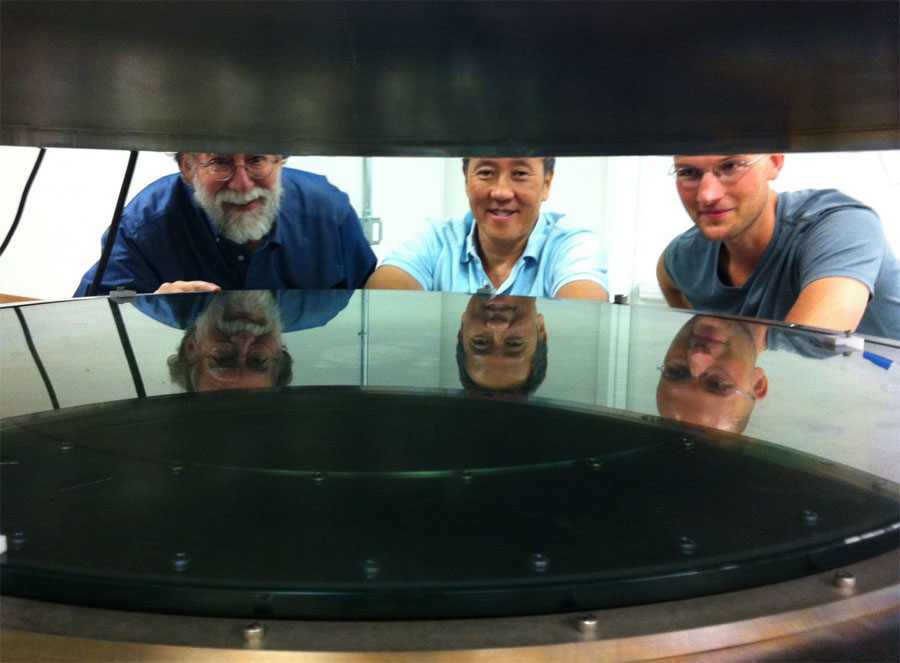
Scaled-Up Mirror-Coating Technology Could Improve Telescope Efficiency
Scientists are adapting atomic layer deposition (ALD), a technique widely used in the microelectronics industry, to develop protected silver coatings suitable for telescope mirrors. These coatings could help telescopes maintain high reflectivity at wavelengths from 340 nm through the mid-IR spectrum. Most astronomical telescope mirrors use aluminum for the reflective layer, even though the reflective properties of silver are superior.
“Silver is the most reflective material, but it is finicky to work with, and it tarnishes and corrodes easily,” said astronomer Andrew Phillips, University of California Santa Cruz (UCSC). “You need barrier layers on top that can keep anything from getting through to the silver without messing up the optical characteristics of the mirror.”
UCSC researchers investigated the effects of ALD on mirror barrier durability, comparing different anti-oxidation materials on silver with an identical aluminum oxide top barrier layer deposited by ALD.
Researchers put samples of coating recipes with different anti-oxidation layers through aggressive environmental testing, including testing for high temperature/high humidity. Results indicated that MgAl2O4, Al2O3, and AlN anti-oxidation layers offered more robust protection against chemical corrosion and moisture in an accelerated aging environment. Researchers attributed this to superior adhesion and intermolecular bonding between the Al-based anti-oxidation layers and the AlOx top barrier layer.
The team further characterized mirror samples by reflectivity/absorption before and after deposition of oxide coatings, and showed that the performance of the ALD-AlOx barrier layer depended in part on the temperature of that process.
The results of the pilot study, which used an ALD system designed for microelectronics, convinced the team to design a larger system that could accommodate telescope mirrors.
“Atomic layer deposition performs significantly better,” Phillips said. “The problem is that the systems used in the electronics industry are designed for silicon wafers, so they’re too small for a telescope window.”
The team filed for a patent on their concept and partnered with Structured Materials Industries (SMI) in Piscataway, N.J., to build a system that could be used for telescope mirrors and other large substrates.

UC Santa Cruz researchers worked with Structured Materials Industries to design and build an atomic layer deposition (ALD) system large enough to accommodate telescope mirrors. Andrew Phillips, Nobuhiko Kobayashi, and David Fryauf (l to r) examine the deposition chamber. Courtesy of Tim Stephens, UCSC.
The new system can accommodate a mirror up to 0.9 meter in diameter, and researchers believe that the design could be scaled up to accommodate even larger mirrors or mirror segments. The 10-meter primary mirrors of the twin Keck Telescopes in Hawaii are composed of hexagonal segments 1.8 meters across, and the mirror segments for the Thirty Meter Telescope (TMT) will be 1.4 meters across.
According to astronomer Michael Bolte, the desire to use silver on the TMT mirror segments is a major driver of the team’s research into novel coating technologies. He expects this technology to also be used to recoat the mirrors of existing telescopes. An aluminum-coated mirror lasts about three to five years before it needs recoating, a process that puts the telescope temporarily out of action.
“We hate to lose telescope time, and we lose a lot of nights recoating segments at Keck,” Phillips said. “We’d like to have a silver coating that could last five to 10 years.”
Currently the researchers are using a physical deposition process to put the silver coating on the mirror blanks along with an initial barrier layer to protect the silver while the mirror is transferred to the ALD system. They use ALD for the final barrier layers.
“Right now, it’s a hybrid process, but we’re following the development of atomic layer deposition for the silver coating as well,” Phillips said.
The mirror-coating technology could have a big impact in astronomy, in the same way that the advent of digital detectors to replace photographic plates gave new life to small telescopes throughout the world several decades ago.
“This is the last trick we have to make existing telescopes more efficient,” said Bolte. “It could really make a big difference.”
The research was published in Proceedings of SPIE (doi: 10.1117/12.2238749).
Published: September 2017